|
|
|
|
|
|
|
|
|
|
EXAMPLES . |
|
|
|
|
|
|
|
|
|
|
|
EXAMPLES . |
|
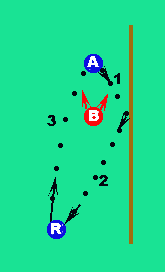 |
1.To work the dribble. With the lateral beam . An attacker (A) with a ball face to face with a defender (B) who is next the beam and an other player , the receiver (R). The (A) does to rebound the ball on the beam which is recovered by the receiver.
|
-Dribbling in the face with his adversary by smalls contacts antero-posterior s with the stick to oblige him to attack. -To send the ball when the adversary is moving. The ball is recovered by the receiver who gives back the ball. In the rebound the ball must touch the beam on the level of the feet of the defender. |
 |
2.To make a corridor of 2 m. broad with two benches. A player is with a ball at a extremity and an adversary at the other.At the time of the signal the carrier of the ball must try to go through the corridor dribbling the ball using the benches. His adversary must try to stop him. Variations: -To vary the distance between the players. -To draw a line between two benches. The carrier of the ball will have to cross the line before his adversary. |
-To take care so that there no body between the players.
- To give to the player who has not the ball a path of displacement longer than that of the carrier. -To take care so that the defender does not strike the stick the carrier. |
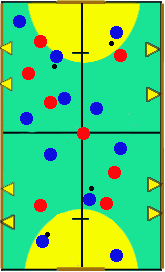 |
3.Situations of opposition. -Play on half-ground :Two players with a ball against one adversary. Variations : Three players with a ball against two adversaries. -Four players with a ball against three adversaries. -To vary the surface of the field of game. - To put two cones to represent a goal. |
-Play in peripheral vision. -To seek to not be marked by adversary. -To keep the ball longest possible. -Not tolerate any technical fault. -To avoid the direct confrontation with the adversary. -Playing the ball is better than dribbling. -To change the roles every 3 minutes. |
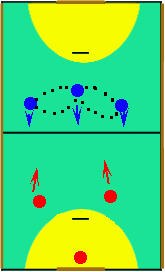 |
4.Three attackers, two defenders and a goalkeeper. The attackers are moving in criss-cross by the criss-cross. As soon as they cross the center line both defender go up to recovery the ball. The objective is to score a goal. variation: To put a fourth player who will not cross the center line and will be used as support of attack. |
- To seek the precision of the pass, the fixing of the adversary and not marking by adversary. -To avoid preserving the ball, and to work the pass running.
-The partners must place themselves towards before and behind the carrier of the ball to support him |
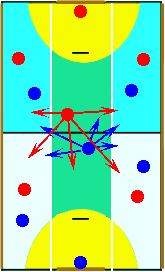 |
5.The area is shared with three longitudinal zones . ( see diagram). The players remain in their zone, except the center which can go where they want to create the surplus . The objective is to score a goal. |
-To discover play at the post: to recognise himself like attackers or defenders. -To discover how to support the carrier of the ball. |
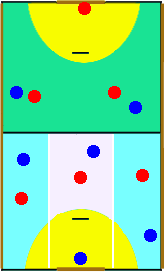 |
6. the area is shared with three zones only ahead.The wingers and the before-center always remain in their zone. The backs can to go where they want in their zone but they must no to go in the zone ahead. The objective is to score a goal by using the supports. |
-To insist on the need for the play at the post : to recognise himself as attacker or defender. - To impose the respect of the role of the players fore post and the players back post. - To approach the possible system of permutation of the players back post and the concept of support between the players for back |
 |
7.The back players at the back remains in the back zone . The players forwards in the before zone . The objective is to score a goal using the support of these players . |
-To play in the post. -Defenders and attackers must not to pass the median line of the area. |
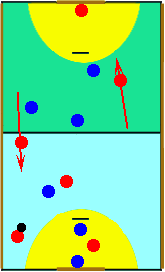 |
8. The same situation that previously . Only the back player on the side of the ball can to pass the median line . |
-If the ball changes of side, the opposite back return in its place to ensure the support. |